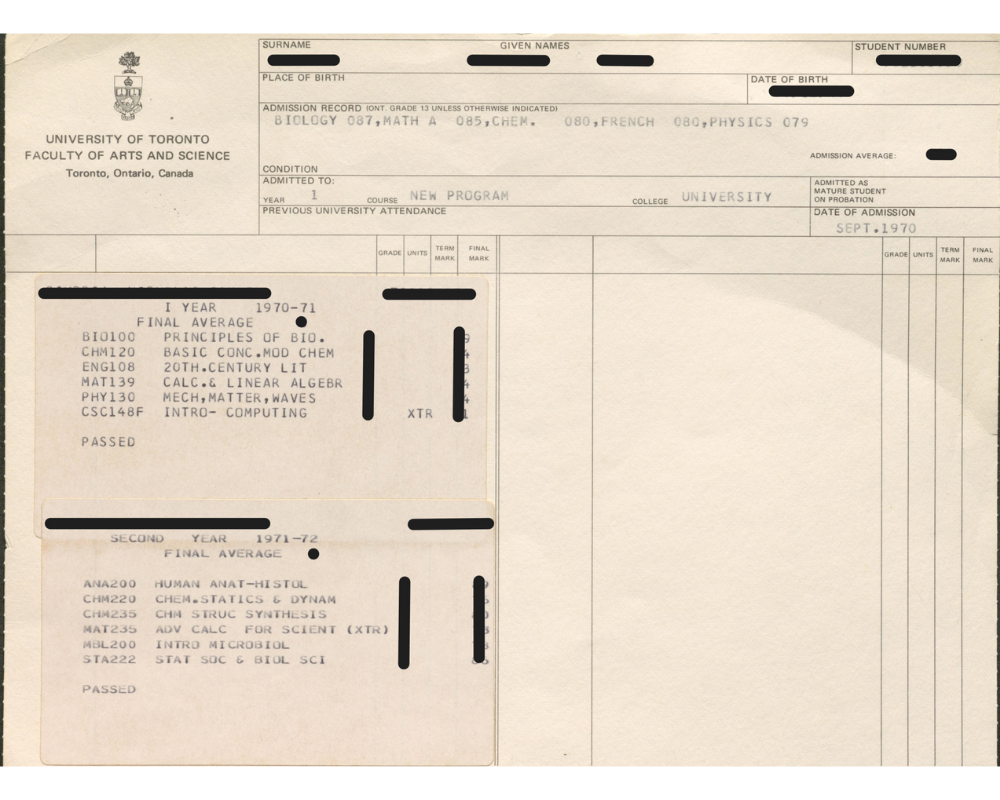From Paper to Pixels: The Evolution of U of T Transcripts
From Paper to Pixels
The Evolution of U of T Transcripts

Transcripts aren’t just a collection of grades – they represent the narrative of an academic journey, the culmination of years of hard work and dedication. Beyond the classroom, they open doors to future opportunities such as graduate programs, scholarships, or employment. As the world entered the digital age, so did the creation, storage, and dissemination of transcripts at U of T, shifting from traditional paper records to digital formats.
The concept of transcripts dates back to the medieval era, evolving as educational institutions gradually adopted formalized methods to record academic achievements. As technology advanced, so did record-keeping in the form of transcripts.
Check out U of T transcripts throughout the years

Paper Transcripts and the Start of Modernization
Imagine a time when transcripts were handwritten on cards and stored in filing cabinets — that was the reality at U of T until the 1980s. “Our oldest records date back to 1892, just a couple years after the devastating fire that destroyed most of University College and many of the even earlier transcripts,” explains Rachelle Allen, service coordinator for transcript services. Allen brings a wealth of knowledge from her 16 years working in transcripts at U of T.
In the past, obtaining a transcript was anything but swift. Each division managed its own transcripts, leading to a slow and time-intensive process. Students had to wait for staff to search through cabinets to locate the transcript card, copy it by hand, and emboss it with the official U of T seal – often taking hours. While technological advancements such as typewriters in the 1920s and microfilm in the 1970s brought some improvements, it wasn’t until the 1980s, with the rise of computers, that a significant shift occurred, creating a much faster transcript production process compared to traditional methods.
Fast forward to fall 1998, a pivotal moment in transcript management with the introduction of the Repository of Student Information (ROSI). “ROSI centralized transcript ordering, making the process more accessible to students. Transcripts were printed off-site, then staff collected, signed, and sealed them in pre-stamped envelopes,” explains Allen. The rise of computers also ushered in fax machines, which became part of the transcript production process. Despite the centralization, divisions continued to handle their own transcripts, a process that involved faxing requests and manual verification.
By 2013, most divisions had adopted the technology and digitized their pre-ROSI records using a central document management system. This transition allowed the University of Toronto Transcript Centre (UTTC) to streamline all transcript printing in-house, utilizing the benefits of a central repository for student records in ROSI.


Click for Convenience: eTranscripts
In 2015, Accessible Campus Online Resource Network (ACORN) replaced the student-facing version of ROSI, offering students the convenience of ordering transcripts with just a few clicks. ACORN’s name was selected a few years earlier from a contest featuring over 1,000 entries, chosen for its simplicity and alignment with the oak-themed imagery of U of T’s logo.

Then came the big leap forward: eTranscripts. While many schools in the USA had already adopted this digital format, U of T was one of the few schools in Canada to provide this service, having partnered with Parchment Exchange in 2019 to offer transcripts electronically. Gone were the days of waiting for snail mail or trekking to campus to collect a physical copy – with eTranscripts, students could receive their documents in just 30 minutes.
eTranscripts not only offer convenience but also reduce U of T’s environmental footprint and ensure security with a digital certificate guaranteeing the transcript’s authenticity. For staff, the shift to digital means less time printing and mailing transcripts, freeing up resources for other essential tasks.
There are approximately 65,000 eTranscript requests annually, a mark of the success of this digital transformation. With the launch of online third-party transcript ordering in 2021, the process is even smoother, allowing external organizations to request eTranscripts on behalf of students.
Despite the changes, transcripts still hold the same significance, capturing the essence of a student’s academic journey, from late-night study sessions to triumphs and setbacks. As the story of transcripts continues to evolve alongside technological progress, they remain a testament to the growth and resilience of students at U of T.
Did you know?
School of Graduate Studies (SGS) transcripts used to indicate marital status and the names of parents/guardians. Some divisions would even include a student’s religion in their record.










